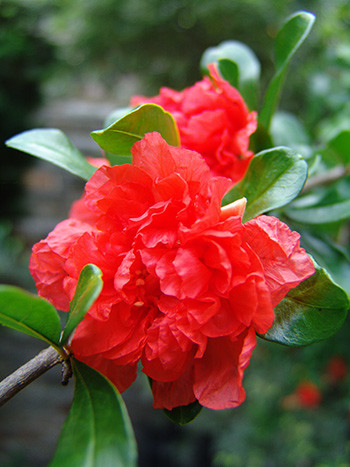
Plants of the Week: June 19
Punica granatum
As you walk along the inner courtyard of Worth Hall you will notice a tall shrub with plentiful bright red flowers: Pomegranate. Scott has four of these ornamental shrubs spread about campus. They will not begin fruiting until the beginning of the fall semester but their flower show is not to be missed.
Punica granatum is endemic to the region of modern-day Iran, so it is drought-resistant and prefers dry soils. In wet soil, fungal infections will cause root decay. Pomegranates can withstand frosts to around 10 degrees Fahrenheit, so be wary of any cold fronts that come through. As pomegranates mature, they develop a unique, sculpture-like branching habit, adding to their effect as a flashy eye-catcher. Do not count on replacing one anytime soon; pomegranates can live for over 200 years.
Punica granatum can be propagated very well from seed, although most breeders will use rooted cuttings so that there is no variation in the fruiting habit of the new shrub. The ease with which cuttings can be grown, coupled with its ornamental growth and long life has made the pomegranate a common choice for bonsai. Photo credit: R. Robert
Mahonia japonica
As you pull into the the visitor parking for the Scott Arboretum look to your left. There you will find a Mahonia japonica nestled into a Carex bed. There are Mahonias all over campus, each displaying the characteristic features which inspired the common name, holly-grape.
Mahonia japonica is an evergreen shrub with long pinnate leaves. Each leaf has six to eight pairs of opposite, holly-shaped leaflets. The leaflets are as sharp as holly leaves, and can hurt when brushed against. Give M. japonica plenty of space when you plant it.
Holly-grape shrubs provide year round entertainment between their foliage and fruiting habits. They develop inflorescences of small yellow flowers in autumn and keep them through winter and into spring. These bee pollinated flowers give way to fantastic blue droops of berries in late spring which contrast brilliantly against their reddish stems. Photo credit: R. Robert
Acer palmatum ‘Waterfall’
Two Acer palmatum ‘Waterfall’ stand guard outside the McCabe Library. These Japanese maples attract attention because they do not have the usual reddish foliage. The leaves of ‘Waterfall’ are a bright fluorescent green. Come autumn, all of the foliage will turn vibrant shades of orange. The tree displays a beautiful weeping habit and never gets much taller than eight feet. It likes partial shade, making it a nice tree to plant under the more commanding trees in your garden, or along the side of your house.
Like other low-growing weeping plants, Acer palmatum ‘Waterfall’ requires a close eye and occasional pruning to avoid its encroaching on other features. Maintaining a good watering schedule is especially important for a newly planted tree. Photo credit: R. Robert








No Comments